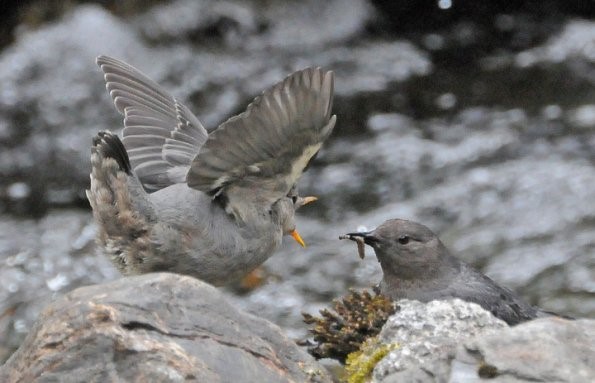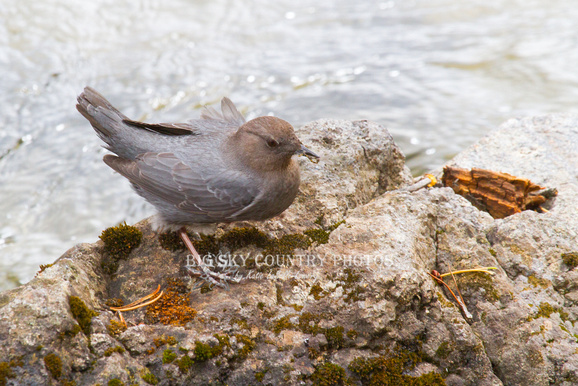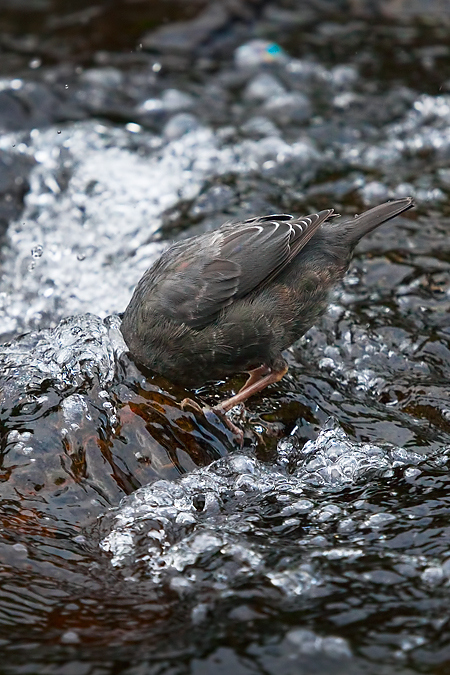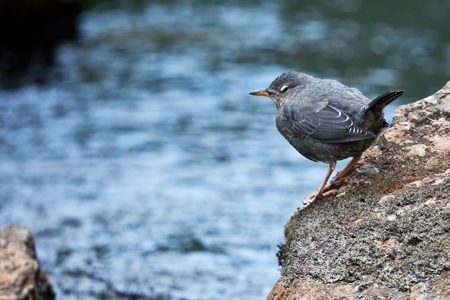
Interesting Facts

There are only five species of the Dipper that have been discovered
as of today (Gilliard 1958) with only one being found in North
America (Reilly 1968). The American Dipper is a surprisingly
interesting organism, regardless of how boring it may look on the
outside.
When a person observes the American Dipper and hears their beautiful
song it is almost a guarantee that they will become fascinated. They
happily sing year round, regardless of the weather outside. Whether
it is sunny or cloudy, their song remains the same (Muir 2013). The
time of year and amount of water may have an effect on the tone in
which they sing. Their song is sung high and strong when streams are
full and softly when there is little water (Reilly 1968). Their song
has a nice varied melody similar to the song of a mocking bird.
There is a combination of gurgling, trilling, and bubbling. Some of
its other songs include an alternation of “zit zit zit zit”, “bz zee
zee zee zee zeet”, and “ching ching ching” (Reilly 1968). Its
alarming call is sharp and very annoying. It can be described as a
double noted:” jgic jgic”. Either way the American Dipper is a very
cheerful bird. Observers have stated that the American Dipper can e asily
grab the attention of anyone around it.
asily
grab the attention of anyone around it.
Other than being a very talkative bird, it is also very energetic. It is always found to be in motion. While looking for food it will occasionally take breaks and then begin a curtseying movement (Milne et al. 1969). It happily bobs up and down making anyone watching smile. While bobbing up and down it also moves its head by either nodding it up and down or turning it side to side (Muir 2013). It also has many other dainty movements that make it a very entertaining to watch.
Another name for the American Dipper is a Water Ouzel, and its scientific name is Cinclus Mexicanus. The group of Cinclus arose in North or South America (Gilliard 1958). They're found to be very closely related to thrushes and wrens (Reilly 1968). The American Dipper is part of the group of Western American Cardilleras which arose from their wren-like ancestors (Austin 1961). When looking at a phylogenetic tree of North American birds we can see that this group is relatively ancient.
The American Dipper is somewhat unique when it comes to migrating
because only a portion of the population actually migrates. And
instead of migrating to a different part of the world, they migrate
upwards. For purposes of comparison we can split the American Dipper
into two groups; the migrants and the residents. When studied it was
found that both groups did less foraging as it got colder outside.
This was because as it gets colder, the places to hunt and things to
eat become scarce. Also there were less hours of daylight. The
residents seemed to spend more time resting and the migrants spent
more of their time foraging (Whitehorne 2010). When their energy
state, physical state and responses were measured and compared there
showed to be no difference between the migrants and residents. The
migrants must be doing something right by moving away during the
winter because they had a higher survival rate than the residents.
This is because they saved their body from enduring the harsh
conditions that negatively affect the birds and they had an
introduction of new food to their diet. When looking at the breeding
differences between those who migrated and those who didn’t, it was
found that the migrants’ offspring were less likely to survive the
first winter than the residents’ offspring. This may be because
their bodies are weaker than those who had parents that were tough
and endured the cold winter instea d
of moving.
d
of moving.
Some random interesting facts about the American Dipper include that it has a very distinctive body odor (Austin 1961). Another random fact is that the blinking membrane of this bird gives it the appearance of a white eye (Perrins et al. 1985). Lastly I found that the American Dipper's molt their wings, tail and feathers every summer, similarly to the Mallard. During this time they are unable to fly. The American dipper is a very interesting bird that I hope I someday have the chance to observe myself.